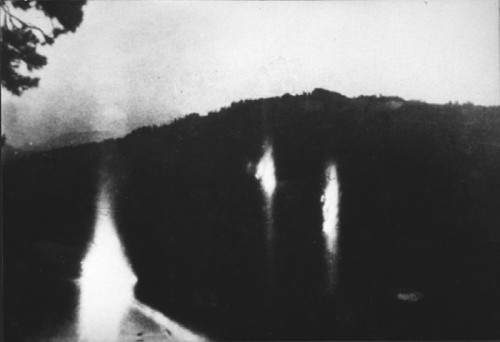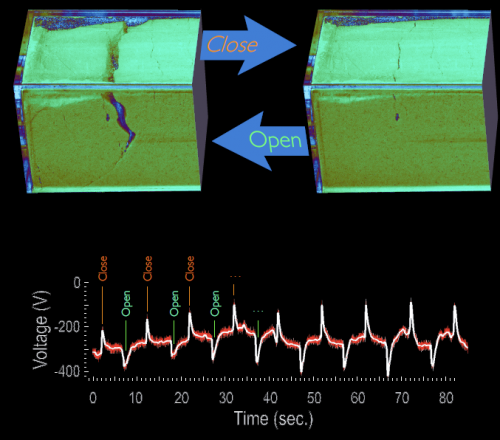
A photograph of streams of lights taken in 1977 near Brasov, Romania, about 100 km from the epicentre of a M 7.2 earthquake. (Courtesy: Seismological Society of America)
By Tushna Commissariat
In case you missed it, I was at the APS March meeting in Denver, Colorado last week and I was blogging about a whole host of interesting talks and sessions that I attended. Although I am back in Bristol now, there were one or two other talks that I thought covered some very interesting physics, so here’s a catch-up.
Slip slidin’ away
Seasoned physicsworld.com readers will remember that earlier this year, we featured a rather intriguing story on the phenomenon of earthquake lights – the mysterious and unpredictable glowing lights that seem to appear before some earthquakes. First documented in the 1600s and seen as recently as the Fukushima earthquake of 2011, the “unidentified glowing objects” add to the long list of possible earthquake precursors, and so are of interest. The study that we wrote about in January looked at 65 well-documented events of such lights and concluded that they may occur thanks to a particular type of geological fault – a subvertical fault – causing the earthquake.
But Troy Shinbrot and Theodore Sui of Rutgers University in the US have taken a decidedly different approach to the matter. The duo told us journalists gathered in the press room that they are looking to granular physics to provide a possible explanation of earthquake lights, suggesting that the shifting and “cracking” of materials in the ground around a geological fault could be the cause.
Shinbrot and Sui have been carrying out a variety of experiments using flour and other granular materials and studying the electrical signals such systems exhibit if they are put through the same sorts of flow, jamming and slip events that occur in earthquake zones. The various granular systems all developed electrical charges at levels that cannot be explained with known physical mechanisms, according to Shinbrot.
“It is quite surprising to us,” said Shinbrot, “to get hundreds of volts by the very low stress, small-scale experiments, essentially consisting of tipping a bed of flour.” He went on to explain that they saw a peak in the voltage each time a crack opened up or closed in the flour in one experiment. Another experiment showed them that voltage spikes coincided with a slip event in a material and that the voltage magnitude grew with the spread of such events. A third granular shear experiment carried out using large polymeric discs also saw the same voltage peaks coinciding with slip events, but further let the researchers conclude that the voltages traced the surfaces of the grains and not their bulk properties.

Electrical spikes of 100 volts or more can result when a crack opens and closes in bed of powder under stress in a laboratory-scale experiment. (Courtesy: Troy Shinbrot, Rutgers University)
Indeed, this means that the internal grain material is not so much the issue as each grain’s surface area and the possible slip-sliding motions that occur, meaning that the grain surfaces may have a major role to play. Some of Sui’s experiments are looking into the importance, if any, of the size of a particle in granular charging and he found that size really does not matter!
Shinbrot and Sui hope that their experiments could help towards developing a new theory to explain charging in granular material, while also paving the way to coming up with a means to pinpoint the epicentre of an earthquake. Also, their work could be rather useful in industry – to monitor the production of ceramics, pharmaceuticals, and other products that require uniform, high-quality powder blends.
Concentrated sunlight
In another session that looked at polymers used to store and convert energy, Emily Warren from the Colorado School of Mines talked about using and adapting NASA thermonuclear devices to produce terrestrial generators. NASA has long developed and used compact, high-temperature, high-concentration solar thermoelectric generators to power its satellites. For example, the Mars rovers use a radioisotope thermonuclear generator that converts heat from plutonium-238 to electricity.
Warren and her colleagues hope to adapt that technology to use in far more “down-to-earth applications”, as it were. Unlike photovoltaic solar cells, which convert light to electricity, thermoelectric generators produce electricity directly from heat. Warren explained that such solar thermoelectric generators could potentially be more efficient than photovoltaics. They are also robust, are scalable and modular – they could be adapted for use in everything from computer to power generators – and would be environmentally friendly.
Flour and air can be very explosive. There have been unexplained cases of explosions in flour mills or transport. Could these have been triggered by this level of voltage?
Any number of gasses could be released through a crack in the formation and the discharge of electrical current could very easily follow the same course or path. This could actually create an electrically charged gas effect the same as that found in any neon light.
Hi Richard
Yes, that was something that Shinbrot and Sui both mentioned. Indeed, they were hoping that their work could better help explain that too.
Cheers
Tushna Commissariat